Monitoring Solar Radiation UV Exposure in the Comoros
Abstract
:1. Introduction
2. Data and Methods
2.1. Data
2.1.1. Ground Measurements
2.1.2. Satellite Measurements
2.2. Methods
2.2.1. Modeling
2.2.2. Clear-Sky Filtering
3. Results
3.1. Climatological Description of UVI, Temperature and Rainfall at Comoros
3.2. Intercomparison between UVI Satellite Estimates or UVI Modeling Estimates and UVI Ground Measurements
3.3. Study Case: Karthala Hike (12 January 2020)
4. Discussion
5. Conclusions
Author Contributions
Funding
Institutional Review Board Statement
Informed Consent Statement
Data Availability Statement
Acknowledgments
Conflicts of Interest
Abbreviations
| AD | Absolute Difference |
| ANACM | Agence Nationale de l’Aviation Civile et de la Météorologie |
| BDC | Brewer Dobson Circulation |
| CAMS | Copernicus Atmospheric Monitoring Service |
| CF | Cloud Fraction |
| GDP | Gross Domestic Product |
| GHG | Greenhouse Gases |
| MODIS | Moderate Resolution Imaging Spectroradiometer |
| NASA | National Aeronautics and Space Administration |
| NIST | National Institute of Standards and Technology |
| ODS | Ozone Depleting Substances |
| OMI | Ozone Monitoring Instrument |
| ORS | Observatoire Régionale de Santé |
| RD | Relative Difference |
| SZA | Solar Zenith Angle |
| TOC | Total Ozone Column |
| TROPOMI | TROPOspheric Monitoring Instrument) |
| UVI | Ultraviolet Index |
| UVR | Ultraviolet Radiation |
| WHO | World Health Organization |
References
- Bernhard, G.H.; Neale, R.E.; Barnes, P.W.; Neale, P.; Zepp, R.G.; Wilson, S.R.; Andrady, A.L.; Bais, A.F.; McKenzie, R.; Aucamp, P.; et al. Environmental effects of stratospheric ozone depletion, UV radiation and interactions with climate change: UNEP Environmental Effects Assessment Panel, update 2019. Photochem. Photobiol. Sci. 2020, 19, 542–584. [Google Scholar] [CrossRef]
- Narayanan, D.L.; Saladi, R.N.; Fox, J.L. Review: Ultraviolet radiation and skin cancer. Int. J. Dermatol. 2010, 49, 978–986. [Google Scholar] [CrossRef]
- Whiteman, D.C.; Watt, P.; Purdie, D.M.; Hughes, M.C.; Hayward, N.K.; Green, A.C. Melanocytic Nevi, Solar Keratoses, and Divergent Pathways to Cutaneous Melanoma. JNCI J. Natl. Cancer Inst. 2003, 95, 806–812. [Google Scholar] [CrossRef] [Green Version]
- Rezvan, F.; Khabazkhoob, M.; Hooshmand, E.; Yekta, A.; Saatchi, M.; Hashemi, H. Prevalence and risk factors of pterygium: A systematic review and meta-analysis. Surv. Ophthalmol. 2018, 63, 719–735. [Google Scholar] [CrossRef] [PubMed]
- Roberts, J.E. Ultraviolet radiation as a risk factor for cataract and macular degeneration. Eye Contact Lens 2011, 37, 246–249. [Google Scholar] [CrossRef] [PubMed]
- Patra, V.; Wagner, K.; Arulampalam, V.; Wolf, P. Skin microbiome modulates the effect of ultraviolet radiation on cellular response and immune function. Iscience 2019, 15, 211–222. [Google Scholar] [CrossRef] [Green Version]
- Norval, M.; McLoone, P.; Lesiak, A.; Narbutt, J. The effect of chronic ultraviolet radiation on the human immune system. Photochem. Photobiol. 2008, 84, 19–28. [Google Scholar] [CrossRef] [PubMed]
- Bouillon, R.; Eisman, J.; Garabedian, M.; Holick, M.; Kleinschmidt, J.; Suda, T.; Terenetskaya, I.; Webb, A. Action Spectrum for the Production of Pre-Vitamin D3 in Human Skin: CIE 174-2006; International Commission on Illumination: Wien, Austria, 2006. [Google Scholar]
- Cela, E.M.; Paz, M.L.; Leoni, J.; Maglio, D.H.G. Immune System Modulation Produced by Ultraviolet Radiation. In Immunoregulatory Aspects of Immunotherapy; IntechOpen: London, UK, 2018; p. 103. [Google Scholar]
- Cadet, J.M.; Bencherif, H.; du Preez, D.J.; Portafaix, T.; Sultan-Bichat, N.; Belus, M.; Brogniez, C.; Auriol, F.; Metzger, J.M.; Ncongwane, K.; et al. Solar UV Radiation in Saint-Denis, La Réunion and Cape Town, South Africa: 10 years Climatology and Human Exposure Assessment at Altitude. Atmosphere 2019, 10, 589. [Google Scholar] [CrossRef] [Green Version]
- Lamy, K.; Portafaix, T.; Brogniez, C.; Lakkala, K.; Pitkänen, M.R.A.; Arola, A.; Forestier, J.B.; Amelie, V.; Toihir, M.A.; Rakotoniaina, S. UV-Indien network: Ground-based measurements dedicated to the monitoring of UV radiation over the western Indian Ocean. Earth Syst. Sci. Data 2021, 13, 4275–4301. [Google Scholar] [CrossRef]
- Cadet, J.M.; Portafaix, T.; Bencherif, H.; Lamy, K.; Brogniez, C.; Auriol, F.; Metzger, J.M.; Boudreault, L.E.; Wright, C.Y. Inter-Comparison Campaign of Solar UVR Instruments under Clear Sky Conditions at Reunion Island (21° S, 55° E). Int. J. Environ. Res. Public Health 2020, 17, 2867. [Google Scholar] [CrossRef] [Green Version]
- Cadet, J.M.; Bencherif, H.; Cadet, N.; Lamy, K.; Portafaix, T.; Belus, M.; Brogniez, C.; Auriol, F.; Metzger, J.M.; Wright, C.Y. Solar UV Radiation in the Tropics: Human Exposure at Reunion Island (21° S, 55° E) during Summer Outdoor Activities. Int. J. Environ. Res. Public Health 2020, 17, 8105. [Google Scholar] [CrossRef]
- Observatoire Régional de la Santé de La Réunion; Melanome Cutane à la Réunion: Saint-Denis, Reunion, France, 2008.
- Calbó, J.; Pagès, D.; González, J.A. Empirical studies of cloud effects on UV radiation: A review. Rev. Geophys. 2005, 43. [Google Scholar] [CrossRef] [Green Version]
- Sabburg, J.; Wong, J. The effect of clouds on enhancing UVB irradiance at the Earth’s surface: A one year study. Geophys. Res. Lett. 2000, 27, 3337–3340. [Google Scholar] [CrossRef]
- Sabburg, J.; Calbó, J. Five years of cloud enhanced surface UV radiation measurements at two sites (in the Northern and Southern Hemispheres). Atmos. Res. 2009, 93, 902–912. [Google Scholar] [CrossRef]
- Du Preez, D.J.; Bencherif, H.; Portafaix, T.; Lamy, K.; Wright, C.Y. Solar Ultraviolet Radiation in Pretoria and Its Relations to Aerosols and Tropospheric Ozone during the Biomass Burning Season. Atmosphere 2021, 12, 132. [Google Scholar] [CrossRef]
- McKenzie, R.L.; Paulin, K.J.; Madronich, S. Effects of snow cover on UV irradiance and surface albedo: A case study. J. Geophys. Res. Atmos. 1998, 103, 28785–28792. [Google Scholar] [CrossRef]
- Holton, J.R.; Haynes, P.H.; McIntyre, M.E.; Douglass, A.R.; Rood, R.B.; Pfister, L. Stratosphere-troposphere exchange. Rev. Geophys. 1995, 33, 403–439. [Google Scholar] [CrossRef]
- Chipperfield, M.P.; Dhomse, S.S.; Feng, W.; McKenzie, R.; Velders, G.J.; Pyle, J.A. Quantifying the ozone and ultraviolet benefits already achieved by the Montreal Protocol. Nat. Commun. 2015, 6, 1–8. [Google Scholar] [CrossRef] [Green Version]
- Butchart, N. The Brewer-Dobson circulation. Rev. Geophys. 2014, 52, 157–184. [Google Scholar] [CrossRef]
- WMO. Scientific Assessment of Ozone Depletion: 2018; Global Ozone Research and Monitoring Project-Report No. 58; WMO; UNEP: Geneva, Switzerland, 2018; p. 588. [Google Scholar]
- Lamy, K.; Portafaix, T.; Josse, B.; Brogniez, C.; Godin-Beekmann, S.; Bencherif, H.; Revell, L.; Akiyoshi, H.; Bekki, S.; Hegglin, M.I.; et al. Clear-sky ultraviolet radiation modeling using output from the Chemistry Climate Model Initiative. Atmos. Chem. Phys. 2019, 19, 10087–10110. [Google Scholar] [CrossRef] [Green Version]
- World Health Organization. Least Developed Countries: Health and WHO: Country Presence Profile; Technical Documents; World Health Organization: Geneva, Switzerland, 2017. [Google Scholar]
- World Health Organization. WHO Country Presence in Small Island Developing States (SIDS); World Health Organization: Geneva, Switzerland, 2021; p. 25. [Google Scholar]
- Direction Général de la Statistique et de la Perspective and ICF International Comores: Enquête Démographique et de Santé et à Indicateurs Multiples (EDSC-MICS II) 2012; Technical Report; DGSP et ICF International: Rockville, MD, USA, 2014.
- McKinlay, A. A reference action spectrum for ultraviolet erythema in human skin. CIE J. 1987, 6, 17–22. [Google Scholar]
- Liandrat, O.; Cros, S.; Braun, A.; Saint-Antonin, L.; Decroix, J.; Schmutz, N. Cloud cover forecast from a ground-based all sky infrared thermal camera. In Remote Sensing of Clouds and the Atmosphere XXII; Comerón, A., Kassianov, E.I., Schäfer, K., Eds.; International Society for Optics and Photonics (SPIE): Warsaw, Poland, 2017; Volume 10424, pp. 19–31. [Google Scholar] [CrossRef]
- Breiman, L. Random forests. Mach. Learn. 2001, 45, 5–32. [Google Scholar] [CrossRef] [Green Version]
- Long, C.N.; Sabburg, J.M.; Calbó, J.; Pagès, D. Retrieving Cloud Characteristics from Ground-Based Daytime Color All-Sky Images. J. Atmos. Ocean. Technol. 2006, 23, 633–652. [Google Scholar] [CrossRef] [Green Version]
- Levelt, P.F.; van den Oord, G.H.J.; Dobber, M.R.; Malkki, A.; Visser, H.; de Vries, J.; Stammes, P.; Lundell, J.O.V.; Saari, H. The ozone monitoring instrument. IEEE Trans. Geosci. Remote Sens. 2006, 44, 1093–1101. [Google Scholar] [CrossRef]
- Tanskanen, A.; Lindfors, A.; Määttä, A.; Krotkov, N.; Herman, J.; Kaurola, J.; Koskela, T.; Lakkala, K.; Fioletov, V.; Bernhard, G.; et al. Validation of daily erythemal doses from Ozone Monitoring Instrument with ground-based UV measurement data. J. Geophys. Res. 2007, 112. [Google Scholar] [CrossRef] [Green Version]
- Arola, A.; Kazadzis, S.; Lindfors, A.; Krotkov, N.; Kujanpää, J.; Tamminen, J.; Bais, A.; di Sarra, A.; Villaplana, J.M.; Brogniez, C.; et al. A new approach to correct for absorbing aerosols in OMI UV. Geophys. Res. Lett. 2009, 36. [Google Scholar] [CrossRef]
- Kinne, S.; O’Donnel, D.; Stier, P.; Kloster, S.; Zhang, K.; Schmidt, H.; Rast, S.; Giorgetta, M.; Eck, T.F.; Stevens, B. MAC-v1: A new global aerosol climatology for climate studies. J. Adv. Model. Earth Syst. 2013, 5, 704–740. [Google Scholar] [CrossRef]
- Lindfors, A.V.; Kujanpää, J.; Kalakoski, N.; Heikkilä, A.; Lakkala, K.; Mielonen, T.; Sneep, M.; Krotkov, N.A.; Arola, A.; Tamminen, J. The TROPOMI surface UV algorithm. Atmos. Meas. Tech. 2018, 11, 997–1008. [Google Scholar] [CrossRef] [Green Version]
- Garane, K.; Koukouli, M.E.; Verhoelst, T.; Lerot, C.; Heue, K.P.; Fioletov, V.; Balis, D.; Bais, A.; Bazureau, A.; Dehn, A.; et al. TROPOMI/S5P total ozone column data: Global ground-based validation and consistency with other satellite missions. Atmos. Meas. Tech. 2019, 12, 5263–5287. [Google Scholar] [CrossRef] [Green Version]
- Krotkov, N.A.; Bhartia, P.K.; Herman, J.R.; Fioletov, V.; Kerr, J. Satellite estimation of spectral surface UV irradiance in the presence of tropospheric aerosols: 1. Cloud-free case. J. Geophys. Res. Atmos. 1998, 103, 8779–8793. [Google Scholar] [CrossRef] [Green Version]
- Herman, J.R.; Labow, G.; Hsu, N.C.; Larko, D. Changes in cloud and aerosol cover (1980–2006) from reflectivity time series using SeaWiFS, N7-TOMS, EP-TOMS, SBUV-2, and OMI radiance data. J. Geophys. Res. Atmos. 2009, 114. [Google Scholar] [CrossRef] [Green Version]
- Tanskanen, A.; Krotkov, N.A.; Herman, J.R.; Arola, A. Surface ultraviolet irradiance from OMI. IEEE Trans. Geosci. Remote. Sens. 2006, 44, 1267–1271. [Google Scholar] [CrossRef]
- Lakkala, K.; Kujanpää, J.; Brogniez, C.; Henriot, N.; Arola, A.; Aun, M.; Auriol, F.; Bais, A.F.; Bernhard, G.; De Bock, V.; et al. Validation of TROPOMI Surface UV Radiation Product. Atmos. Meas. Tech. Discuss. 2020, 2020, 1–37. [Google Scholar] [CrossRef]
- Bozzo, A.; Arola, A.; Cesnulyte, V.; Pitkänen, M. Report on Implementation of Spectral UV Irradiance, MACC-III Deliverable D57.2, Work Package 122; Technical Report; Copernicus Atmosphere Monitoring Service: Reading, UK, 2015. [Google Scholar]
- Madronich, S.; McKenzie, R.; Björn, L.; Caldwell, M. Changes in biologically active ultraviolet radiation reaching the Earth’s surface. J. Photochem. Photobiol. B Biol. 1998, 46, 5–19. [Google Scholar] [CrossRef]
- Lamy, K.; Portafaix, T.; Brogniez, C.; Godin-Beekmann, S.; Bencherif, H.; Morel, B.; Pazmino, A.; Metzger, J.M.; Auriol, F.; Deroo, C.; et al. Ultraviolet radiation modeling from ground-based and satellite measurements on Reunion Island, southern tropics. Atmos. Chem. Phys. 2018, 18, 227–246. [Google Scholar] [CrossRef] [Green Version]
- Dobber, M.; Voors, R.; Dirksen, R.; Kleipool, Q.; Levelt, P. The High-Resolution Solar Reference Spectrum between 250 and 550 nm and its Application to Measurements with the Ozone Monitoring Instrument. Sol. Phys. 2008, 249, 281–291. [Google Scholar] [CrossRef] [Green Version]
- Gorshelev, V.; Serdyuchenko, A.; Weber, M.; Chehade, W.; Burrows, J.P. High spectral resolution ozone absorption cross-sections; Part 1: Measurements, data analysis and comparison with previous measurements around 293 K. Atmos. Meas. Tech. 2014, 7, 609–624. [Google Scholar] [CrossRef] [Green Version]
- Serdyuchenko, A.; Gorshelev, V.; Weber, M.; Chehade, W.; Burrows, J.P. High spectral resolution ozone absorption cross-sections; Part 2: Temperature dependence. Atmos. Meas. Tech. 2014, 7, 625–636. [Google Scholar] [CrossRef] [Green Version]
- McPeters, R.D.; Labow, G.J. Climatology 2011: An MLS and sonde derived ozone climatology for satellite retrieval algorithms. J. Geophys. Res. Atmos. 2012, 117. [Google Scholar] [CrossRef] [Green Version]
- Madronich, S. Analytic Formula for the Clear-sky UV Index. Photochem. Photobiol. 2007, 83, 1537–1538. [Google Scholar] [CrossRef]
- Koepke, P.; Bais, A.; Balis, D.; Buchwitz, M.; De Backer, H.; de Cabo, X.; Eckert, P.; Eriksen, P.; Gillotay, D.; Heikkilä, A.; et al. Comparison of models used for UV index calculations. Photochem. Photobiol. 1998, 67, 657–662. [Google Scholar] [CrossRef]
- Lacagnina, C.; Hasekamp, O.P.; Bian, H.; Curci, G.; Myhre, G.; van Noije, T.; Schulz, M.; Skeie, R.B.; Takemura, T.; Zhang, K. Aerosol single-scattering albedo over the global oceans: Comparing PARASOL retrievals with AERONET, OMI, and AeroCom models estimates. J. Geophys. Res. Atmos. 2015, 120, 9814–9836. [Google Scholar] [CrossRef] [Green Version]
- Fitzpatrick, T.B. The validity and practicality of sun-reactive skin types I through VI. Arch. Dermatol. 1988, 124, 869–871. [Google Scholar] [CrossRef]
- Kosmopoulos, P.G.; Kazadzis, S.; Schmalwieser, A.W.; Raptis, P.I.; Papachristopoulou, K.; Fountoulakis, I.; Masoom, A.; Bais, A.F.; Bilbao, J.; Blumthaler, M.; et al. Real-time UV index retrieval in Europe using Earth observation-based techniques: System description and quality assessment. Atmos. Meas. Tech. 2021, 14, 5657–5699. [Google Scholar] [CrossRef]
- Vitt, R.; Laschewski, G.; Bais, A.F.; Diémoz, H.; Fountoulakis, I.; Siani, A.M.; Matzarakis, A. UV-Index Climatology for Europe Based on Satellite Data. Atmosphere 2020, 11, 727. [Google Scholar] [CrossRef]
- Bilbao, J.; de Migue, A. Erythemal Solar Irradiance, UVER, and UV Index from Ground-Based Data in Central Spain. Appl. Sci. 2020, 10, 6589. [Google Scholar] [CrossRef]
- Lamy, K.; Portafaix, T. Ultraviolet Index measurements in the Indian Ocean. Zenodo 2021. [Google Scholar] [CrossRef]
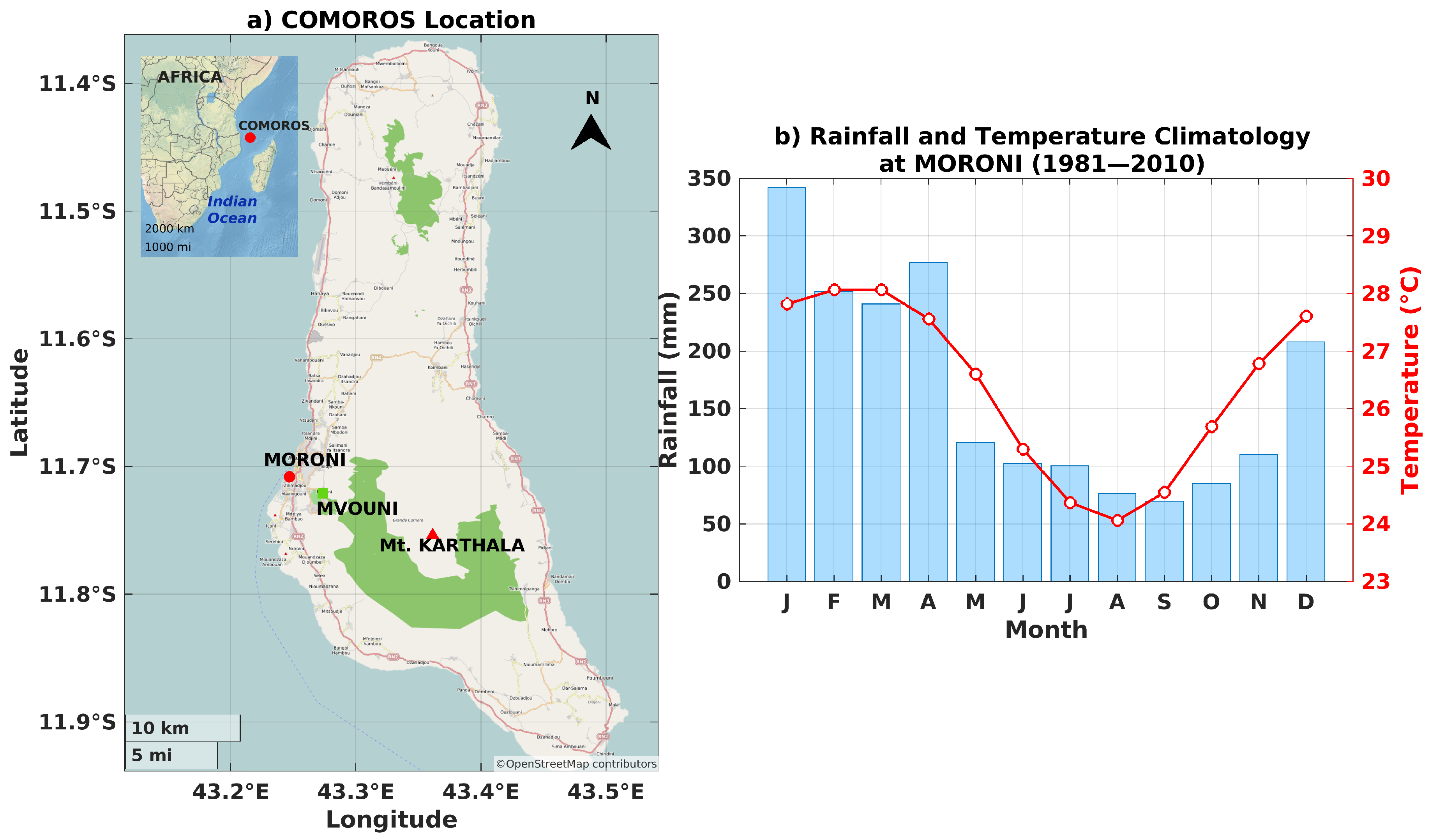
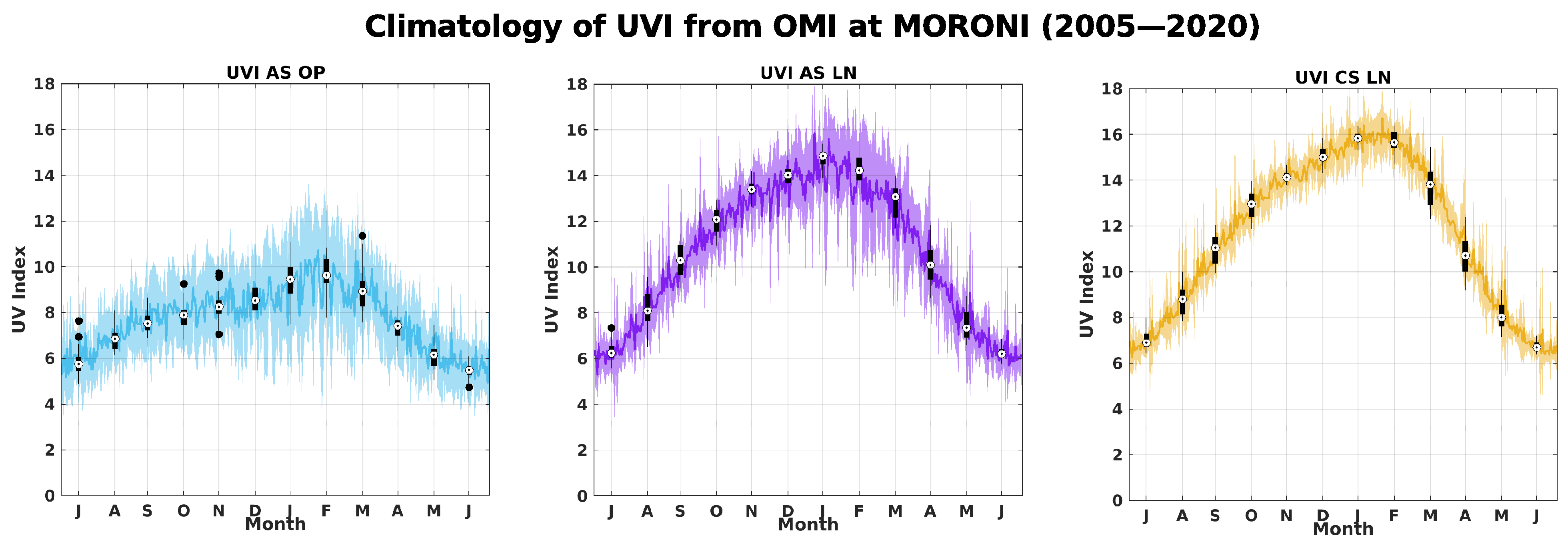
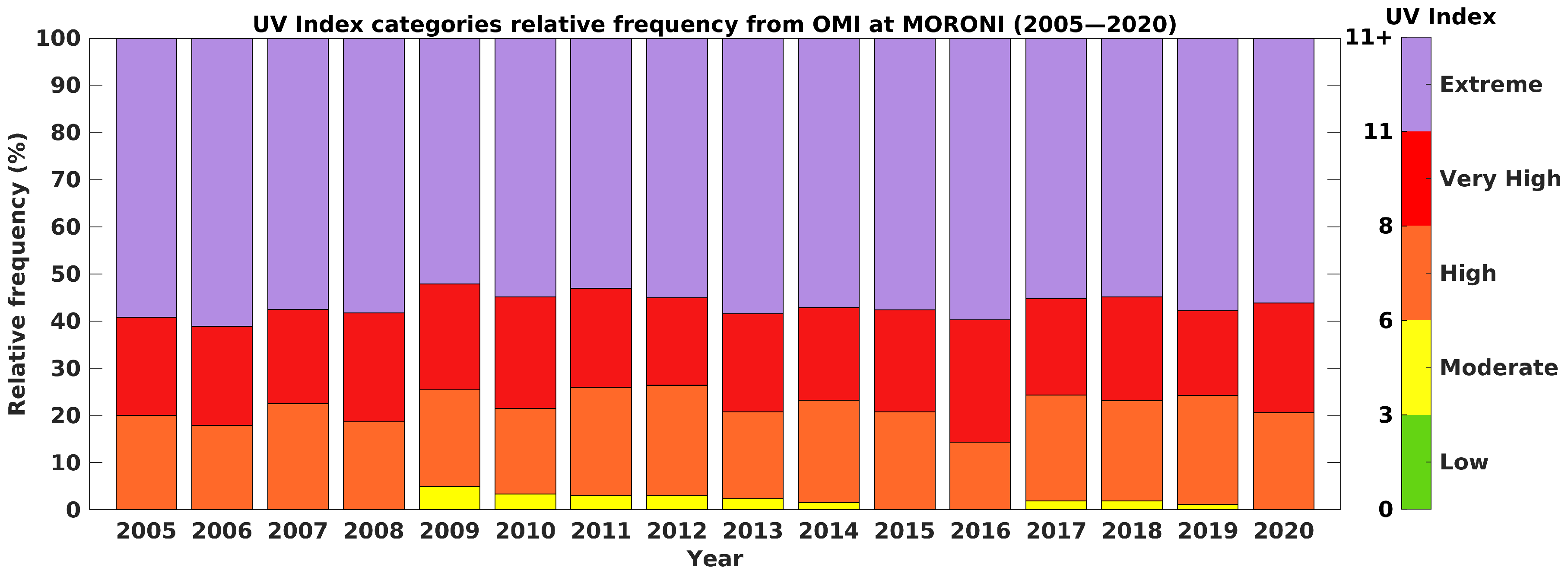
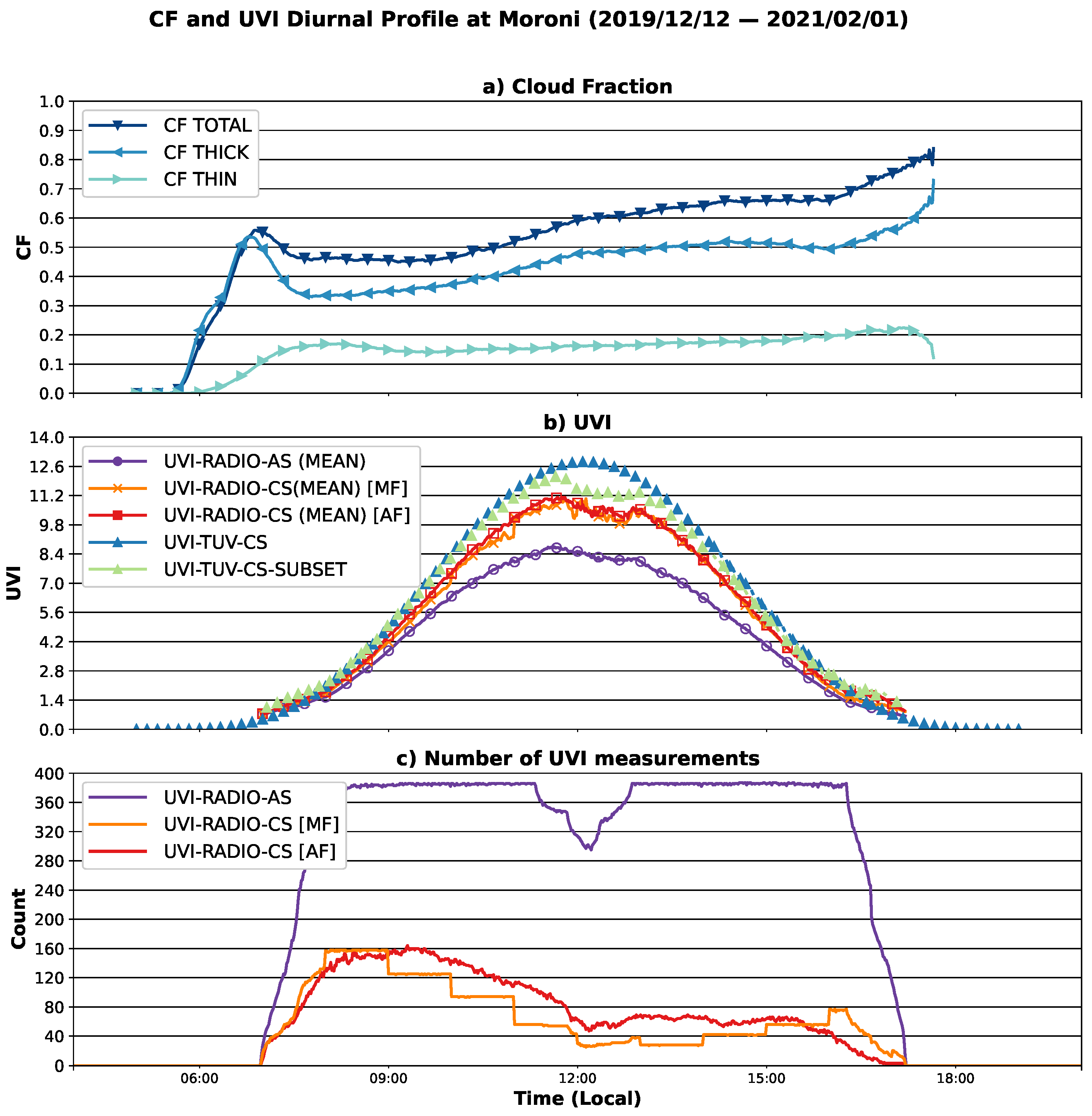

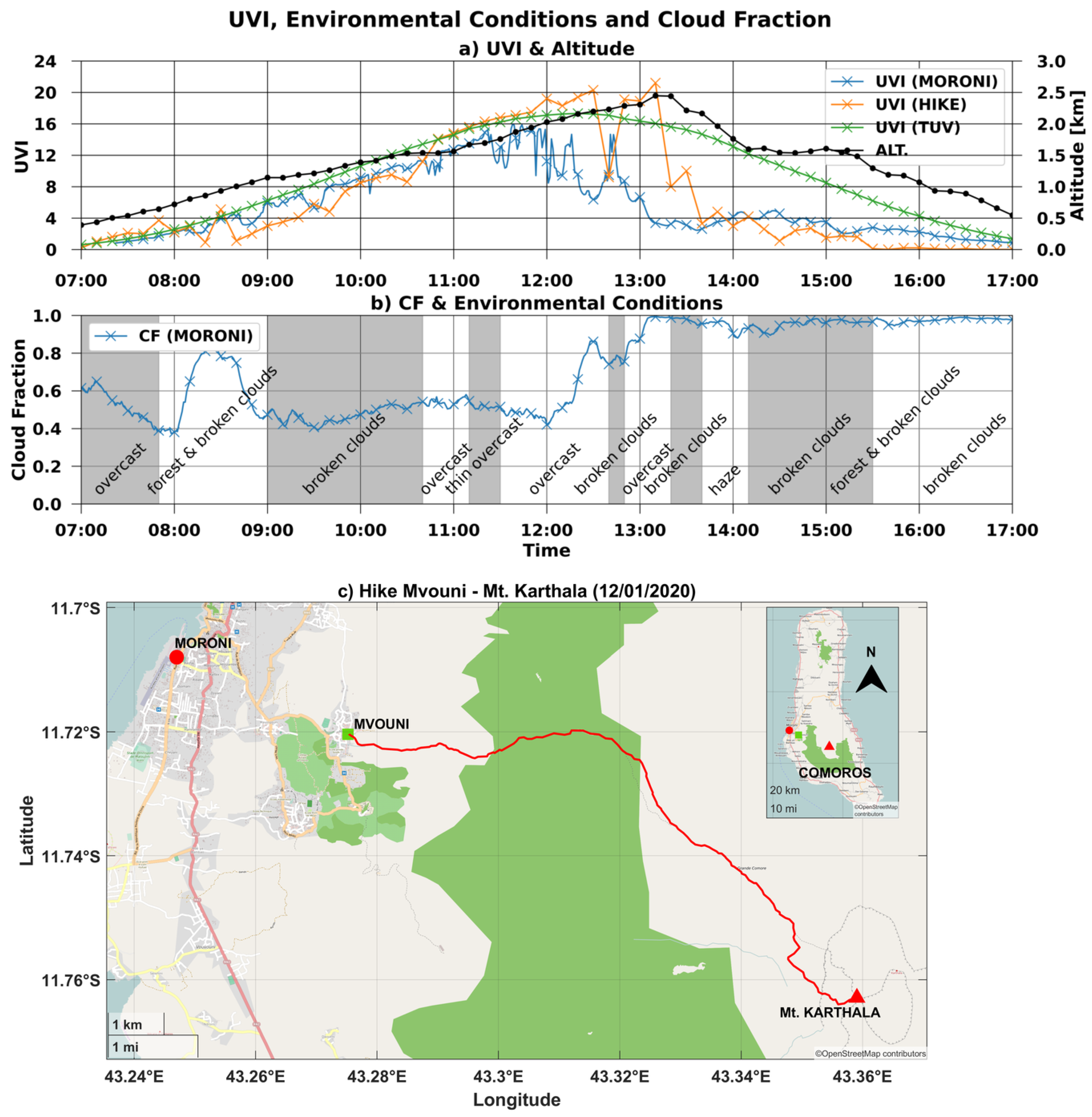
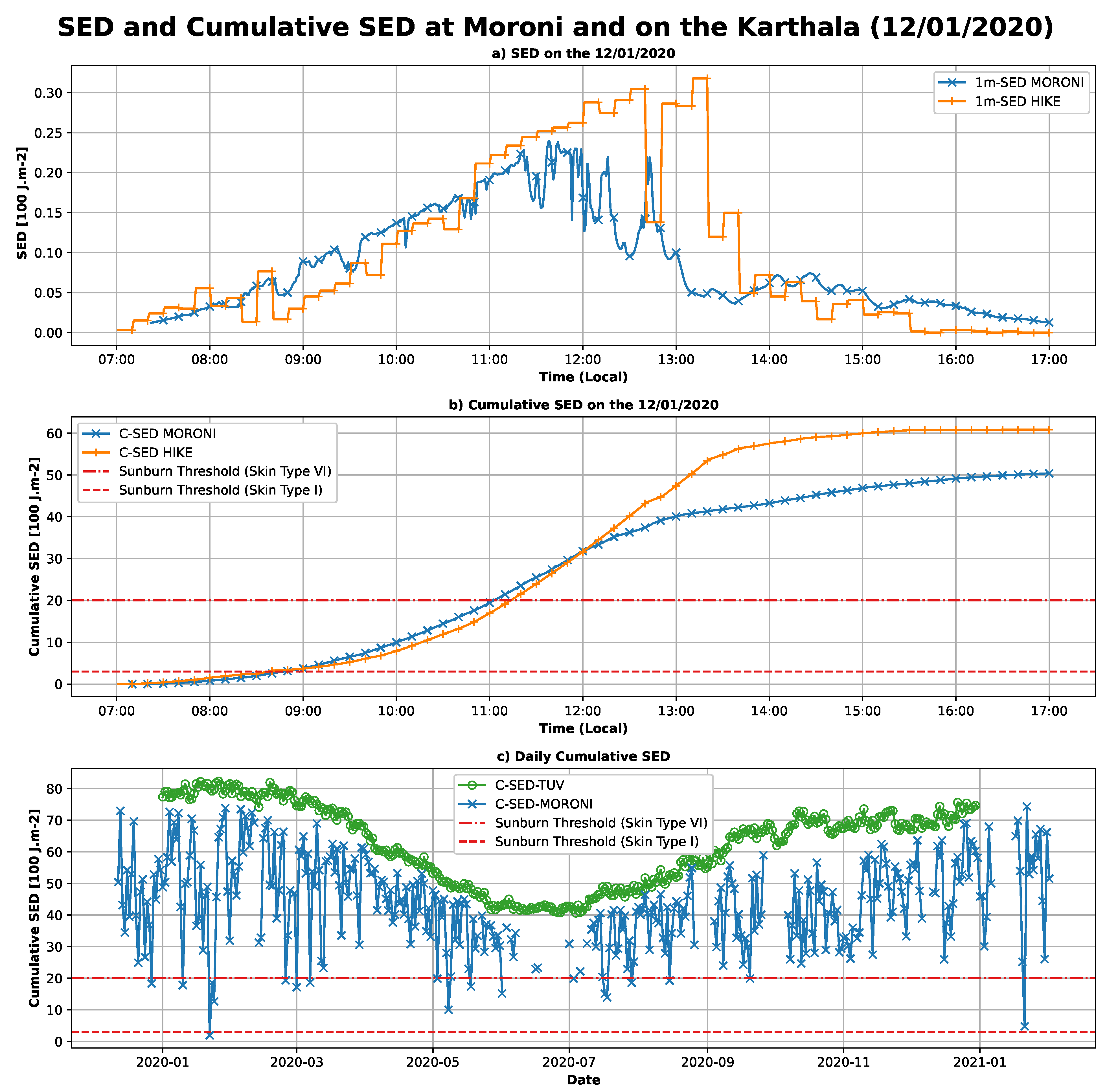
| Dataset | Platform | Type | Resolution | Field Used for Computation/Calibration | Temporal Coverage | References | |
|---|---|---|---|---|---|---|---|
| Ozone Field Used | Aerosol Field Used | ||||||
| RADIOMETER | Ground-Based | Radiometer Kipp&Zonen UVS-E-T | dt = 1 or 5 min | OMUVG | None | December 2019–March 2021 | Cadet et al. [12] |
| OMUVBG | Satellite | Spectrometer Measurement at 360 nm then LUT | Daily Overpass/Solar Noon 0.25 × 0.25 deg | OMI | Krotkov et al. [38] Herman et al. [39] | 2004–2020 | Tanskanen et al. [40] Arola et al. [34] Levelt et al. [32] |
| TROPOMI | Satellite | Spectrometer Measurement at 354 nm then LUT | Daily Overpass/Solar Noon 5.6 × 3.7 km | TROPOMI L2 total ozone column product Garane et al. [37] | Aerosol Climatology Kinne et al. [35] | November 2017–April 2021 | Lindfors et al. [36] Lakkala et al. [41] |
| CAMS | Model | Modelling | dt = 6 h 40 km (after 21 June 2016) 80 km (before 21 June 2016) | Modelled | Modelled | June 2016–April 2021 | Bozzo et al. [42] |
| Stats | UVI-TROPOMI-AS | UVI-TROPOMI-CS | UVI-CAMS-AS | UVI-CAMS-CS | UVI-TUV-CS-SUBSET |
|---|---|---|---|---|---|
| Mean RD [%] | 63.4 ± 183.1 | 5.8 ± 8.8 | 93.1 ± 552.4 | 9.9 ± 11.9 | 10.7 ± 12.7 |
| Mean AD [UVI] | 2.0 ± 1.7 | 0.5 ± 0.7 | 2.4 ± 2.4 | 0.7 ± 0.6 | 0.9 ± 0.7 |
| Median RD [%] | 19.7 | 3.4 | 23.3 | 7.1 | 7.5 |
| Median AD [UVI] | 1.6 | 0.3 | 1.7 | 0.4 | 0.7 |
| R2 | 0.68 | 0.93 | 0.55 | 0.98 | 0.95 |
| Ndata | 416 | 62 | 577 | 111 | 14,386 |
Publisher’s Note: MDPI stays neutral with regard to jurisdictional claims in published maps and institutional affiliations. |
© 2021 by the authors. Licensee MDPI, Basel, Switzerland. This article is an open access article distributed under the terms and conditions of the Creative Commons Attribution (CC BY) license (https://creativecommons.org/licenses/by/4.0/).
Share and Cite
Lamy, K.; Ranaivombola, M.; Bencherif, H.; Portafaix, T.; Toihir, M.A.; Lakkala, K.; Arola, A.; Kujanpää, J.; Pitkänen, M.R.A.; Cadet, J.-M. Monitoring Solar Radiation UV Exposure in the Comoros. Int. J. Environ. Res. Public Health 2021, 18, 10475. https://doi.org/10.3390/ijerph181910475
Lamy K, Ranaivombola M, Bencherif H, Portafaix T, Toihir MA, Lakkala K, Arola A, Kujanpää J, Pitkänen MRA, Cadet J-M. Monitoring Solar Radiation UV Exposure in the Comoros. International Journal of Environmental Research and Public Health. 2021; 18(19):10475. https://doi.org/10.3390/ijerph181910475
Chicago/Turabian StyleLamy, Kévin, Marion Ranaivombola, Hassan Bencherif, Thierry Portafaix, Mohamed Abdoulwahab Toihir, Kaisa Lakkala, Antti Arola, Jukka Kujanpää, Mikko R. A. Pitkänen, and Jean-Maurice Cadet. 2021. "Monitoring Solar Radiation UV Exposure in the Comoros" International Journal of Environmental Research and Public Health 18, no. 19: 10475. https://doi.org/10.3390/ijerph181910475
APA StyleLamy, K., Ranaivombola, M., Bencherif, H., Portafaix, T., Toihir, M. A., Lakkala, K., Arola, A., Kujanpää, J., Pitkänen, M. R. A., & Cadet, J.-M. (2021). Monitoring Solar Radiation UV Exposure in the Comoros. International Journal of Environmental Research and Public Health, 18(19), 10475. https://doi.org/10.3390/ijerph181910475







